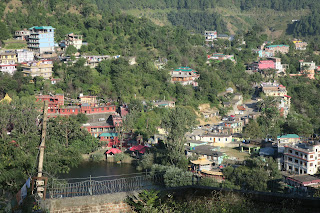Rewalsar Lake is a mid-altitude lake located on a mountain spur in the Mandi district, 22.5 km south-west from Mandi, in India. Its elevation is about 1,360 m above sea level.
The lake is shaped like a square with the shoreline of about 735 m. It is held as a sacred spot for Hindus, Sikhs and Buddhists.
There are three Buddhist monasteries at Rewalsar. The lake also has three Hindu temples dedicated to Lord Krishna, Lord Shiva and to the sage Lomas. Another holy lake, Kunt Bhyog which is about 1,750 m above sea level lies above Rewalsar. It is associated with the escape of 'Pandavas' from the burning palace of wax—an episode from the epic Mahabharata.
It was from here that the Indian teacher and 'Tantric' Padmasambhava left for Tibet. Known to the Tibetans as 'Guru Rinpoche', the Precious Master, it was under Padmasambhava's influence that Mahayana Buddhism spread over Tibet.
Mandarava and Padmasambhava were energetically drawn to one another. Vihardhara, fearful of the contamination of the royal bloodline and what he perceived as Mandarava's apostasy, endeavoured to have Mandarava and Padmasambhava purified by immolation through the flames of a pyre. Instead of finding their corpses incensed and charred, Vihardhara finds that the fire of the pyre has been transformed into Lake Rewalsar, out of which arises a blooming lotus that supports the unharmed Mandarava and Padmasambhava who through this manifestation of their realisation have achieved their secret names of Vajravarahi and Hayagriva, respectively, after which Vihardhara furnishes the union with his unreserved blessings.
Legend has it that the great teacher Padmasambhava (Guru Rinpoche) used his enormous power to take flight to Tibet from Rewalsar. In Rewalsar, his spirit is said to reside in the tiny island of floating reed that drifts over the water.
|
Rewalsar Lake (Tso Pema) seen from west. |
|
Panoramic view of the lake. |
|
Guru Rinpoche Statue from the northeast.
|
|
Guru Rinpoche Statue from south. |
|
Walking towards Guru Rinpoche Statue. |
|
Rewalsar Lake (center) and Guru Rinpoche Statue (right). |
|
Back of Guru Rinpoche Statue.
|
See also
Source
Location














